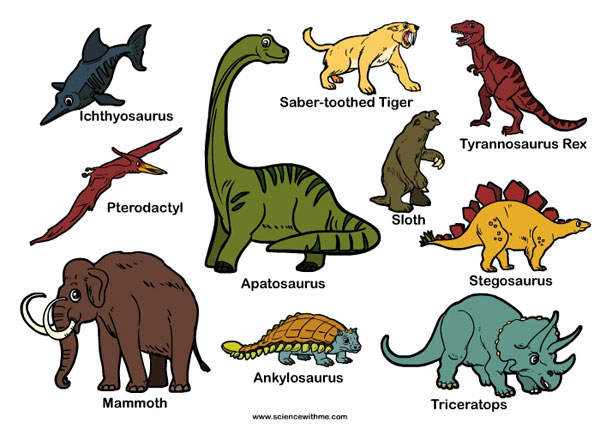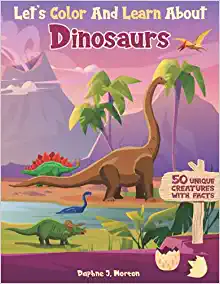If you have watched any of the Jurassic Park movies, you might find dinosaurs scary.
What are dinosaurs?
Dinosaurs were the main inhabitants of the earth starting about 230 million years ago and ending about 65 million years ago (late Triassic period to Cretaceous period). In phylogenetic classification, the word Dinosauria is a Superorder and is used to refer to all dinosaurs. However, dinosaurs can be divided further into two orders: Order Saurischia (lizard-hipped dinosaurs) and Order Ornithischia (bird-hipped dinosaurs). The word dinosaur comes from the Greek word “deinos” which means “terrible” and the Greek word “sauros’ which refers to a lizard or a reptile. The name dinosaur therefore leads people to think of a very large creature with magnificent claws and teeth. It is true that many dinosaurs were big but most were actually the size of humans or were even smaller. The largest relatively complete dinosaur fossil ever discovered was the Giraffatitan brancai, which was previously called Brachiosaurus. The reconstructed fossil remains from a creature that was about 12 meters tall and 22.5 meters long which also led scientists to conclude that the actual dinosaur weighed between 30,000– 60,000 kilograms. Although possibly larger dinosaurs have been discovered, their fossils were fragmented. For instance, the Argentinosaurus is said to have weighed 80,000-100,000 kilograms and Sauroposeidon would have been about 18 meters tall. The smallest dinosaurs, on the other hand, were only about as big as pigeons. For instance, Anchiornis only had a skeleton as long as 35 inches and would have weighed about 110 grams.

What was the behavior of dinosaurs?
Most people believe that a dinosaur was cold-blooded, sluggish and unintelligent. However, since the 1970s, scientists are proving that dinosaurs were very active and were involved in socialization. This means that they also interacted with their fellow dinosaurs similar to the way we interact with our fellow human beings or the way other animals interact with each other. Scientists believe that herding behavior was present among dinosaurs. This was because there have been places where hundreds and even thousands of dinosaur tracks were found. There have also been locations where multiple dinosaurs of the same species died. This herding behavior may have been caused by the dinosaurs’ desire to migrate or to protect their young. Most of the dinosaurs laid eggs and warmed their eggs similar to the way a chicken broods over her eggs or her young. Parent dinosaurs may have fed their hatched young and communicated with them, similar to the way birds and crocodiles do. So did dinosaurs really attack each other? It seems so. Fossils of a Protoceratops being attacked by a Velociraptor was discovered in 1971. Another fossil of an Edmontosaurus shows that its tail was probably bitten by a tyrannosaur but it was able to escape and survive.
How did dinosaurs walk?
Some dinosaurs walked with four limbs on the ground (quadrupeds) but many dinosaurs walked in the same way that you walk—erect or upright (bipeds). This erect posture actually provided an advantage to these animals. Compared to the sprawling reptiles, they were able to breathe more easily, particularly when they moved. This upright posture also allowed them to have greater stamina compared to modern reptiles. Moreover, scientists theorize that erect limbs helped decreased the bending stress on their extremities, thereby, helping support their large sizes.
Did winged dinosaurs really exist?
Yes, they did. In fact, the most diverse group of dinosaurs consisted of “birds” or avian dinosaurs. Most winged dinosaurs are classified under order Saurischia. Note that it was mentioned earlier that members of the Order Saurischia were lizard-hipped. Therefore, modern birds actually evolved from dinosaurs that were lizard-hipped. There were about 9,000 species of avian dinosaurs. One such dinosaur is called Pteradonon. You can see what it looked like in our free Pteradonon Dinosaur Worksheet. Bird-like species were able to climb trees.
Were there herbivorous dinosaurs?
Yes, there were dinosaurs that preferred eating plants. One example is the Triceratops. A worksheet of this dinosaur can be found and can be downloaded for free. Here. Herbivorous dinosaurs mainly ate angiosperms. The names for herbivorous dinosaurs depends on their body structure. For instance, ornithopods were bipedal or quadrupedal herbivores, stegosaurians were plated quadrupeds, ceratopsians were horned and frilled quadrupeds, sauropodomorphs were long-necked and long-tailed quadrupeds, and ankylosaurians were armored quadrupeds. The Triceratops belongs to the group of ceratopsians and it is said to be among the last dinosaurs to have disappeared before extinction.



